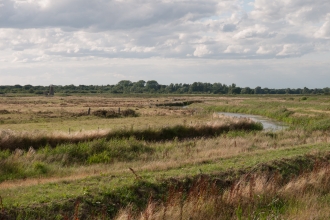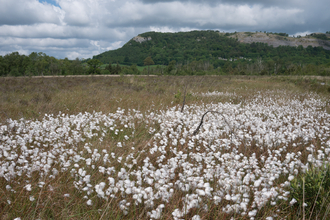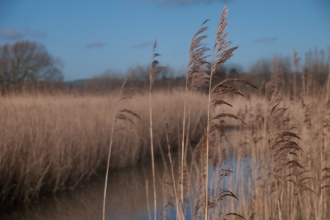
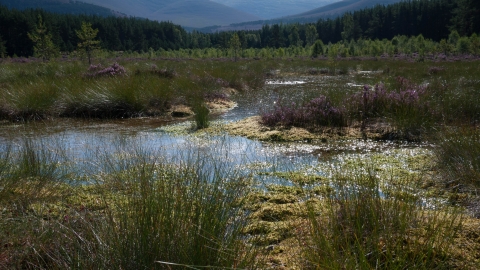
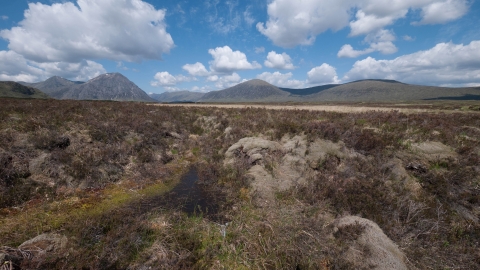

Gorgors
Beth yw o?
Blanket bog is extensive and widespread in the wetter west and north of the UK. Generally an upland habitat, it can be found from 1000m down to sea level where peat has accumulated to a depth of at least 0.5m - generally on flat or gently sloping ground where drainage is poor. Few plants are adapted to the acidic, infertile conditions found on the deepest peat and bog-mosses, heathers and cotton grasses predominate. Towards the drier east, dwarf shrubs become more common and include bearberry, bog bilberry and mountain crowberry at higher altitudes, while on steeper slopes in the west, purple moor-grass can dominate.
Pam fod o fel hyn?
In the UK, the development of blanket bog began around 5,000-6,000 years ago, as the climate became wetter and warmer. It is generally found over acidic bedrock in places where rainfall exceeds the loss of water through evaporation and plant transpiration, leading to near-constant saturation. Such conditions favour the growth of bog-mosses and cottongrasses, which do not break down when they die but slowly accumulate as peat. Layers of peat create a barrier between the bog vegetation and the ground water and underlying rock and, fed only by rainwater, the bog becomes increasingly acidic and low in nutrients.
In many places, the development of blanket bog was aided by forest clearance carried out by humans, as the loss of trees increased waterlogging. However, in very wet, cool places such as the Flow Country in Caithness and Sutherland and on the Northern Isles, blanket bog is thought to have developed naturally.
In the southern Uplands of Scotland and the south Pennines, extensive areas of blanket bog have been degraded, for example through past air pollution from nearby industrial towns, over-grazing and repeated burning. These bogs are largely dominated by hare’s-tail cotton grass.
Dosbarthiad yn y DU
Around 2.25 million ha of blanket bog is found in the UK, most of it in Scotland. It is confined to the wetter west and north of the country, from Dartmoor to Shetland. Britain and Ireland hold over 20% of the worlds blanket bog.
Beth i edrych am
The acidity and nutrient-poor conditions do not favour a wide diversity of plants, but look out for specialists such sundews, butterworts and bladderworts – all carnivores adapted to catch and digest small invertebrates. In particularly wet areas, look for small pools and hollows aligned in repeating series and created by the varying growth forms of different bog-mosses.
Vertebrates are found at low densities in this infertile environment, but the presence of waders such as golden plover, dunlin and (in Scotland) greenshank may be betrayed by their eerie calls. Birds of prey such as golden eagle, hen harrier, and short-eared owls may be seen hunting over blanket bog. Remote lochans can support breeding red-throated diver and common scoter.
Blanket bog provides habitat for both terrestrial and aquatic invertebrates. Look for black darter, common hawker and (in Scotland only) azure hawker dragonflies around bog pools. Even in dull weather, it is worth looking out for the large heath butterfly around mid-July - its caterpillars feed on hare’s-tail cottongrass and adults nectar on cross-leaved heath.
Cadwraeth
Although the area of blanket bog in UK is substantial, a significant amount has been degraded or lost. Industrial peat extraction has destroyed bogs, while tax breaks in the 1980s led to the afforestation of vast tracts of the Flow Country. Government subsidies for drainage resulted in shallow drains being dug across huge areas of upland peatlands and subsidised over-grazing has also had a detrimental effect. Burning to promote fresh growth for livestock or for grouse on sporting estates has a longer history, but is the most significant current threat. Burning leads to the loss of peat-forming bog mosses and results in peat desiccation, shrinkage and erosion. The possible response of the habitat to likely changes in rainfall as a consequence of climate change are complex, and it is recognised that increasing resilience through the restoration of degraded bog is a priority - much work has already been done in developing suitable techniques.

